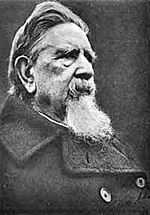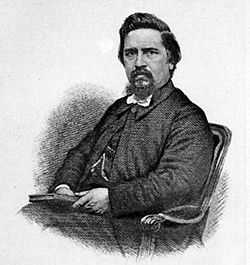Griffith John
| ||||||||
Griffith John (Chinese name 杨格非) (14 December 1831 – 25 July 1912) was a Welsh Christian missionary and translator in China. A member of the Congregational church, he was a pioneer evangelist with the London Missionary Society (LMS), a writer and a translator of the Holy Bible into the Chinese language.
Biography
Griffith John was born on 14 December 1831 at Swansea, in south Wales. He was brought up a Christian in the Congregational tradition, and in 1840 at the age of eight was admitted to full membership of Ebenezer Congregational church, Swansea. When only fourteen he delivered his first sermon at a prayer meeting; at sixteen he became a regular preacher. He was subsequently trained at the Brecon Congregational Memorial College for the ministry, and then at the Bedford Academy.
In 1853 he offered his services to the London Missionary Society and after two years' training was ordained in 1855 at Ebenezer, Swansea. That same year he married his first wife, Margaret Jane, a daughter of the Christian missionary, David Griffiths. After ordination he offered himself for service in Madagascar. But he was persuaded by the London Missionary Society to accept appointment to China, and the newly wed couple made the voyage to Shanghai arriving in September 1855. Griffith John would serve in China for 55 years, chiefly in Hubei and Hunan.
John became known for his extensive missionary journeys into the Chinese interior - journeys that sometimes stretched to 5,000 km or more. He was among the first to begin Christian missionary work in the provinces of Hubei (Hupeh), Hunan, and Sichuan (Szechwan). He set up schools, hospitals and training colleges, with a permanent base at Hankou (now part of Wuhan city) in Hubei. In 1861 he went from Shanghai through the provinces of central China, and he later claimed that with his colleagues he had established over 100 mission stations in Hubei and Hunan.[1] In July of that year he had moved to Hankou, which remained his base until his final departure from China in 1912 - although in 1863 he was in neighbouring Wuchang District (now part of Wuhan city), and in 1867 Hanyang District (also now part of Wuhan city).

John, fluent in both spoken and written Chinese, made a major contribution to the Church in China as author, translator, and preacher. A powerful and eloquent speaker, he was popular with the Chinese, who would gather in great numbers to hear him preach. He was notably successful in training and mentoring numerous Chinese evangelists. He was also a prolific pamphleteer, authoring numerous popular tracts and serving for many years as chairman of the Central China Tract Society.
Mrs John suffered from ill health. In 1870, she and her husband left China for a rare visit to Britain; but in 1873 she died in Singapore during the return voyage. In 1874, John met and married Mrs Jenkins, a missionary's widow. In 1885, his second wife died.
In 1890, he became a founding member of the Permanent Committee for the Promotion of Anti-Opium Societies. Fellow committee members were prominent missionaries John Glasgow Kerr MD, American Presbyterian Mission in Canton; BC Atterbury MD, American Presbyterian Mission in Peking, Archdeacon Arthur Evans Moule, Church Missionary Society in Shanghai, Henry Whitney MD, American Board of Commissioners for foreign Missions in Foochow, the Rev Samuel Clarke, China Inland Mission in Kweiyang and the Rev Arthur Gostick Shorrock, English Baptist Mission in Taiyuan.[2] They resolved to continue their opposition to the opium traffic, urging Christians in China to arouse public opinion against it. The desire of the missionaries that their ideas be carried out caused them to form "continuation committees" that were assigned tasks to assure that action would be taken on whatever matters had been approved by the conferences.
Having acquired an intimate knowledge of the Chinese language and literature, John translated the New Testament and a great part of the Old Testament into more than one Chinese dialect. He made a Mandarin Chinese translation of the New Testament, Psalms, and Proverbs, as well as a Wen-li New Testament, published in 1885.
In 1888 or 1889 he was elected chairman of the Congregational Union of England and Wales, but declined the honor and remained in Hankou among the Chinese whom he loved. In the Yangtze valley he founded a theological college for Chinese preachers, which bears his name. The University of Edinburgh conferred on him the degree of D.D. (1889) in recognition of his service to the Chinese.
In 1905 John celebrated his missionary jubilee at Hankou. For health reasons he left China for a short time but returned in 1907. During a career spanning 60 years John left China only three times. Finally returning to Britain in January 1912, he died in London on 25 July that year. Griffith John was buried at Bethel Chapel on Carnglas Road, Sketty in Swansea following a funeral service in Ebenezer Chapel.
Legacy
In 2012, a bust of Griffith John by sculptor Xiang Jinguo was placed in Swansea Museum - a gift from the Union Hospital, Wuhan, who established a programme of cooperation with Swansea University's School of Medicine.[3] In September 2013, a blue plaque was unveiled in memory of John outside Ebenezer Chapel, Swansea, where he worshiped as a boy.[4]
Works
- John, Griffith (1907). A Voice from China London: James Clarke &Co. -University of Hong Kong Libraries, Digital Initiatives, China Through Western Eyes
Notes
- ↑ Who's who in the Far East. Hong Kong: The China Mail. June 1906. p. 166.
- ↑ Lodwick, Kathleen L. Crusaders Against Opium: Protestant Missionaries in China 1874-1917 (University Press of Kentucky) Online version at Google Books [ISBN 0813119243]
- ↑ website bbc.co.uk/news/uk-wales-south-west-wales-20534117 (30 November 2012)
- ↑ "Blue plaque unveiled in memory of Swansea missionary Griffith John". South Wales Evening Post. Retrieved 2014-05-07.
References
 This article incorporates text from a publication now in the public domain: Chisholm, Hugh, ed. (1922). "John, Griffith". Encyclopædia Britannica (12th ed.). London & New York.
This article incorporates text from a publication now in the public domain: Chisholm, Hugh, ed. (1922). "John, Griffith". Encyclopædia Britannica (12th ed.). London & New York.
Further reading
- W. Robson, Griffith John, founder of the Hankow Mission (5th ed., 1901?)
- R. Wardlaw Thompson, Griffith John: The story of fifty years in China (1906)
- G. John, A Voice from China (1907)
- H. M. Hughes, Dr Griffith John D.D. Arwr China (1914)
- Joyce Reason, Griffith John of China: A biography (Eagle Books, London, 1950)
- Noel Gibbard, Griffith John: Apostle to Central China (Bridgend, 1998)
- Hudson Taylor & China’s Open Century Volume Six: Assault on the Nine; Alfred James Broomhall; (Hodder and Stoughton and Overseas Missionary Fellowship, 1988)
| ||||||||||||||||||||||||||||
|

